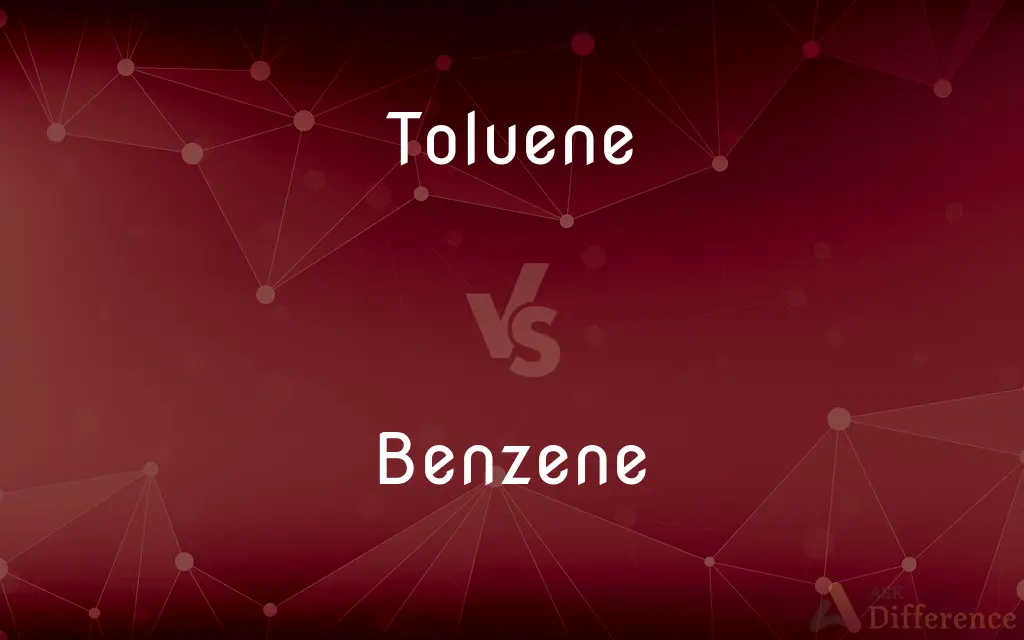Toluene vs. Benzene — What's the Difference?
By Fiza Rafique & Maham Liaqat — Updated on April 17, 2024
Toluene, a benzene derivative with a methyl group, is less dense and toxic than benzene but both are volatile and used as solvents.

Difference Between Toluene and Benzene
Table of Contents
ADVERTISEMENT
Key Differences
Toluene and benzene are both aromatic hydrocarbons used extensively in industry, primarily as solvents and chemical precursors.
Toluene, chemically known as methylbenzene, contains a methyl group attached to the benzene ring, which influences its chemical properties and uses. On the other hand, benzene is a simpler compound with a ring structure consisting solely of carbon and hydrogen atoms.
Toluene is generally considered less toxic than benzene; benzene is known for its carcinogenic properties, making toluene a safer alternative in many applications.
While both are used as solvents, toluene's ability to dissolve paints, plastics, and rubber is particularly valued in the manufacturing and automotive industries. Benzene's toxicity has led to stricter regulations and reduced use in consumer products, whereas toluene, while still hazardous, is subject to slightly less stringent controls.
The presence of the methyl group in toluene makes it a more reactive molecule compared to benzene, which is significant in chemical synthesis where toluene can undergo reactions at the methyl group that benzene cannot.
ADVERTISEMENT
Comparison Chart
Chemical Structure
C6H5CH3 (methylbenzene)
C6H6
Density
Less dense than benzene
More dense than toluene
Toxicity
Less toxic, non-carcinogenic
Highly toxic, carcinogenic
Use as a Solvent
Strong solvent for paints, plastics
Used less due to toxicity
Regulations
Subject to health safety regulations, but less stringent than benzene
Highly regulated due to carcinogenicity
Chemical Reactivity
Higher due to methyl group
Lower, lacks functional groups
Compare with Definitions
Toluene
An aromatic hydrocarbon with the chemical formula C6H5CH3, used widely as an industrial solvent.
Toluene is often found in paint thinners due to its solvent properties.
Benzene
Historically used as a solvent, but this use has declined due to health concerns.
Benzene was once commonly used in consumer products like adhesives and paints.
Toluene
Still hazardous with exposure risks requiring careful handling.
Toluene exposure can affect the nervous system, requiring safety measures in workplaces.
Benzene
Known for its carcinogenic properties, it poses significant health risks.
Long-term exposure to benzene is linked to leukemia.
Toluene
Less toxic compared to benzene, making it preferable in many industrial applications.
Manufacturers prefer toluene over benzene to reduce health risks.
Benzene
Used in the synthesis of a wide range of other chemicals.
Benzene is a precursor in the manufacture of drugs, plastics, and dyes.
Toluene
Commonly found in the manufacture of explosives where it is used to produce TNT.
Toluene is a key ingredient in the production of trinitrotoluene (TNT).
Benzene
A colorless and highly flammable liquid with the formula C6H6, primarily used as a starting material in the manufacture of plastics, resins, and synthetic fibers.
Benzene is crucial in the production of nylon and other polymers.
Toluene
Known for its ability to dissolve a variety of substances, making it useful in chemical synthesis.
Toluene is used to produce other chemicals like benzene and xylene.
Benzene
Subject to strict environmental and safety regulations to minimize human exposure.
Workplace benzene levels are heavily regulated to protect workers.
Toluene
Toluene (), also known as toluol (), is an aromatic hydrocarbon. It is a colorless, water-insoluble liquid with the smell associated with paint thinners.
Benzene
Benzene is an organic chemical compound with the molecular formula C6H6. The benzene molecule is composed of six carbon atoms joined in a planar ring with one hydrogen atom attached to each.
Toluene
A colorless flammable aromatic liquid, C7H8, obtained from coal tar or petroleum and used in aviation fuel and other high-octane fuels, in dyestuffs, explosives, and as a solvent for gums and lacquers. Also called methylbenzene.
Benzene
A colorless, flammable, toxic, liquid aromatic hydrocarbon, C6H6, derived from petroleum and used in or to manufacture a wide variety of chemical products, including DDT, detergents, insecticides, and motor fuels. Also called benzol.
Toluene
(organic compound) A colourless, inflammable liquid hydrocarbon, methylbenzene, CH3.C6H5, used as a solvent, in high-octane fuels and in the production of many chemical compounds.
Benzene
(organic compound) An aromatic hydrocarbon of formula C6H6 whose structure consists of a ring of alternate single and double bonds.
Toluene
A hydrocarbon, C6H5.CH3, of the aromatic series, homologous with benzene, and obtained as a light mobile colorless liquid, by distilling tolu balsam, coal tar, etc.; - called also methyl benzene, phenyl methane, etc.
Benzene
Sometimes used in place of the phenyl group.
Toluene
A colorless flammable liquid obtained from petroleum or coal tar; used as a solvent for gums and lacquers and in high-octane fuels
Benzene
A volatile, very inflammable liquid, C6H6, contained in the naphtha produced by the destructive distillation of coal, from which it is separated by fractional distillation. The name is sometimes applied also to the impure commercial product or benzole, and also, but rarely, to a similar mixed product of petroleum.
Benzene
A colorless liquid hydrocarbon; highly inflammable; carcinogenic; the simplest of the aromatic compounds
Common Curiosities
How do environmental regulations affect the use of toluene and benzene?
Both chemicals are regulated, but benzene faces stricter controls due to its carcinogenic properties.
Can both toluene and benzene be found in consumer products?
Toluene can still be found in products like paint thinners, while benzene's use in consumer products has been greatly reduced due to its toxicity.
What makes benzene more regulated than toluene?
Benzene's status as a known carcinogen has led to stricter regulations to limit human exposure and protect public health.
Are there any alternatives to using these chemicals?
Safer alternatives are being developed, but many industries still rely on toluene and benzene for their effectiveness in various applications.
How do toluene and benzene impact environmental health?
Both chemicals can contribute to environmental pollution and pose risks to wildlife and ecosystems, necessitating careful management and disposal practices.
What safety precautions are necessary when handling these chemicals?
Proper ventilation, use of personal protective equipment, and adherence to regulatory guidelines are crucial when handling both toluene and benzene.
What are the primary uses of toluene and benzene?
Toluene is mainly used as a solvent and chemical precursor, whereas benzene is used in the synthesis of polymers and other chemicals.
Why is toluene considered less toxic than benzene?
Toluene is less toxic due to the presence of the methyl group, which makes it less harmful compared to the highly carcinogenic benzene.
Can benzene and toluene be recycled or reused in industrial processes?
Yes, recovery and recycling methods are employed in industries to minimize waste and reduce exposure, enhancing environmental sustainability.
What industries are most affected by regulations on benzene and toluene?
Industries such as chemical manufacturing, petroleum refining, and automotive are significantly impacted by regulations governing the use of these solvents.
Share Your Discovery

Previous Comparison
British vs. English
Next Comparison
Deride vs. DerisionAuthor Spotlight
Written by
Fiza RafiqueFiza Rafique is a skilled content writer at AskDifference.com, where she meticulously refines and enhances written pieces. Drawing from her vast editorial expertise, Fiza ensures clarity, accuracy, and precision in every article. Passionate about language, she continually seeks to elevate the quality of content for readers worldwide.
Co-written by
Maham Liaqat













































